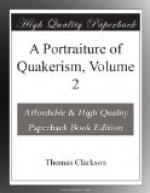He then shows what this baptism is, and calls it the answer of a good conscience towards God by the resurrection of Jesus Christ. In fact, he states it to be the baptism of Christ, which is by the Spirit. For he maintains, that he only is truly baptized, whose conscience is made clear by the resurrection of Christ in his heart. But who can make the answer of such a conscience, except the Holy Spirit shall have first purified the floor of the heart; except the spiritual fan of Christ shall have first separated the wheat from the chaff, and except his spiritual fire shall have consumed the latter?
St. Paul makes a similar declaration: “For as many of you as have been baptized into Christ, have put on Christ."[156] But no man, the Quakers say, merely by being dipped under water, can put on Christ, that is, his life, his nature, his disposition, his love, meekness, and temperance, and all those virtues which should characterise a Christian.
[Footnote 156: Galat 3. 27.]
To the same purport are those other words by the same Apostle:[157] “Know ye not, that so many of us as were baptized unto Jesus Christ, were baptized into his death; that like as Christ was raised up from the dead by the glory of the Father, even so we also should walk in newness of life.” And again—[158] “Buried with him in baptism, wherein also ye are risen with him, through the faith of the co-operation of God, who hath raised him from the dead.” By these passages the Apostle Paul testifies that he alone is truly baptized, who first dies unto sin, and is raised up afterwards from sin unto righteousness, or who is raised up into life with Christ, or who so feels the inward resurrection and glory of Christ in his soul, that he walks in newness of life.
[Footnote 157: Rom. 6.3.4]
[Footnote 158: Colos. 2.12]
The Quakers show again, that the baptism of John could not have been included in the great commission, because the object of John’s baptism had been completed even before the preaching of Jesus Christ.
The great object of John’s baptism, was to make Jesus known to the Jews. John himself declared this to be the object of it. [159] “But that he should be made manifest unto Israel, therefore am I come baptizing with water.” This object he accomplished two ways; first, by telling all whom he baptized that Jesus was coming, and these were the Israel of that time; for he is reported to have baptized all Jerusalem, which was the metropolis, and all Judea, and all the country round about Jordan. Secondly, by pointing him out personally.[160] This he did to Andrew, so that Andrew left John and followed Jesus. Andrew, again, made him known to Simon, and these to Philip, and Philip to Nathaniel; so that by means of John, an assurance was given that Jesus of Nazareth was the Christ.
[Footnote 159: John 1.31.]
[Footnote 160: John 1.40.]
The Quakers believe again, that the baptism of John was not included in the great commission, because it was a type under the law, and all types and shadows under the law were to cease under the Gospel dispensation, or the law of Christ.




